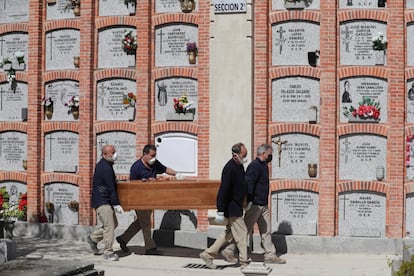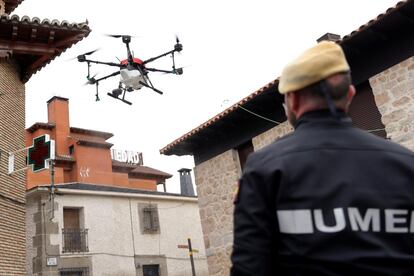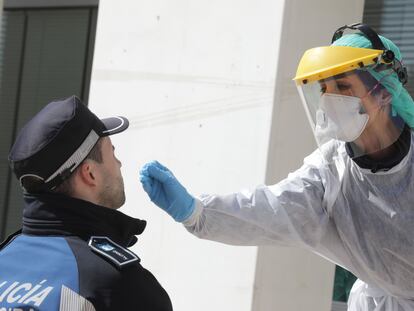Coronavirus deaths in Madrid for second half of March could exceed official figures by 3,000
Deputy regional premier admits that as many as 3,479 of the people who died last month inside the region’s senior centers showed symptoms but were never counted as official victims of Covid-19

An analysis of death records in the Madrid region covering the second two weeks of March suggests that the real number of coronavirus deaths could be much higher than official figures state. The records show an unexplained rise in mortality of around 3,000 people during this period.
Between March 14 and 31, Madrid’s civil registries issued 9,007 burial licenses, according to figures released on Tuesday by the Madrid regional High Court. This is more than twice as many deaths as were recorded during the entire month of March 2019, which was 4,125 according to the National Statistics Institute (INE).
The INE data is not available in 15-day intervals, but based on the monthly figures, it is possible to estimate that there were an average of 133 deaths a day in the Madrid region in March 2019, which multiplied by 18 equals 2,394 deaths between March 14 and 31 of last year.
During the same period this year, there were 9,007 deaths – an increase of 6,613. Yet official figures put the number of deaths due to the coronavirus during that time period at 3,439.
Cause of death

The key to understanding the gap between these numbers lies in how a death caused by the coronavirus is defined. The Health Ministry has asked regional authorities to report confirmed Covid-19 deaths, which means that only people who were tested and whose tests came back positive for the disease are counted in the official figures.
This automatically excludes people who died in senior residences or in their own homes and who were never tested. In these cases, the death certificate does not show coronavirus as the cause of death, but simply cardiorespiratory arrest or respiratory failure.
A few regional governments have released information about suspicious deaths, particularly inside senior homes, which have become epicenters of coronavirus outbreaks. But these are not included in the official figures, which require confirmation of the presence of the coronavirus through PCR (polymerase chain reaction) lab tests.
There could be additional causes underlying the spike in deaths, such as the fact that the overwhelmed healthcare system may be failing to provide proper assistance to non-coronavirus related patients. Epidemiologists also note that the virus could be speeding up the deaths of people with serious pre-existing health problems.
Deaths in Madrid residences

On Wednesday, the deputy premier of the Madrid region, Ignacio Aguado, admitted that as many as 3,479 out of the 4,750 people who died in March inside the region’s 710 centers for seniors and people with disabilities showed symptoms of having the coronavirus, but were never counted as official victims.
Of the 4,750 deaths, only 781 were included in the official tally of Covid-19 fatalities, because those victims were tested – a condition for adding a person to the official coronavirus death count. Another 3,479 residents died with symptoms of the coronavirus, but were never tested for it. This figure, added to the 781 confirmed cases, makes a total of 4,260 coronavirus-related deaths in the month of March.
“I want to send out a message of solidarity and condolences to all the families that have sustained a loss,” said Aguado at a virtual news conference. “The figures are much higher than on an ordinary month, because when the virus enters a residence, it wreaks havoc.”
Aguado also said that from now on, the regional government will start releasing figures on deaths at residences twice a week.
Clear definition
On Tuesday, Health Minister Salvador Illa defended Spain’s method for tallying coronavirus deaths. “Spain has a clear definition, one of the strictest in Europe,” he said.
In the Madrid region, the official number of coronavirus deaths since the beginning of the pandemic is 5,321 as of Tuesday. During the March 14-31 period, 3,439 deaths were officially attributed to the coronavirus.
This accounts for approximately half of the 6,613 rise in burial licenses issued by Madrid’s civil registries during the same period compared with 2019. The numbers suggest there might have been around 3,000 unreported coronavirus deaths in the Madrid region over the period.
If so, it would confirm studies on the spike in mortality rates conducted by the Carlos III Health Institute, which looked at death records from Spain’s civil registries.
According to this center’s latest study, updated on April 6, there were 51.2% more deaths than expected in Spain between March 17 and April 6. The figure for the region of Castilla-La Mancha was 196%, and in Madrid it was 121.6%.
These numbers are being provided by a daily mortality monitoring system known as MoMo, which was created in 2004 to track the impact of heatwaves in Spain. The system identifies deviations in daily mortality compared with what would be expected based on historical series.
English version by Susana Urra.
Tu suscripción se está usando en otro dispositivo
¿Quieres añadir otro usuario a tu suscripción?
Si continúas leyendo en este dispositivo, no se podrá leer en el otro.
FlechaTu suscripción se está usando en otro dispositivo y solo puedes acceder a EL PAÍS desde un dispositivo a la vez.
Si quieres compartir tu cuenta, cambia tu suscripción a la modalidad Premium, así podrás añadir otro usuario. Cada uno accederá con su propia cuenta de email, lo que os permitirá personalizar vuestra experiencia en EL PAÍS.
¿Tienes una suscripción de empresa? Accede aquí para contratar más cuentas.
En el caso de no saber quién está usando tu cuenta, te recomendamos cambiar tu contraseña aquí.
Si decides continuar compartiendo tu cuenta, este mensaje se mostrará en tu dispositivo y en el de la otra persona que está usando tu cuenta de forma indefinida, afectando a tu experiencia de lectura. Puedes consultar aquí los términos y condiciones de la suscripción digital.
More information
Últimas noticias
Most viewed
- Sinaloa Cartel war is taking its toll on Los Chapitos
- Oona Chaplin: ‘I told James Cameron that I was living in a treehouse and starting a permaculture project with a friend’
- Reinhard Genzel, Nobel laureate in physics: ‘One-minute videos will never give you the truth’
- Why the price of coffee has skyrocketed: from Brazilian plantations to specialty coffee houses
- Silver prices are going crazy: This is what’s fueling the rally










































